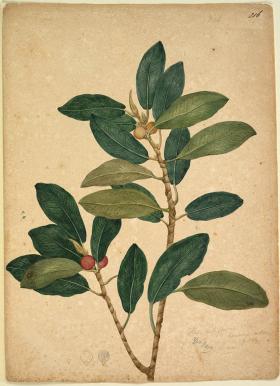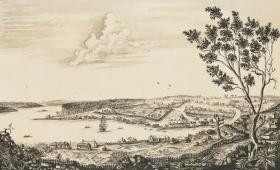Challenges to convict survival
By examining primary sources students explore the difficulties of survival for First Fleet convicts through disease, starvation, living conditions and severe punishment.
Key inquiry question #1
Why did Europeans settle in Australia?
Key inquiry question #2
What was the nature and consequence of contact between Aboriginal and/or Torres Strait Islander peoples and early traders, explorers and settlers?
Learning intention
Students are learning to:
- understand the hardship of everyday life for First Fleet convicts
- recognise the challenges of survival in the early colony
- interrogate sources of information
Success criteria
Students will be successful when they can:
- establish the risks to the convicts’ health and life in the colony
- describe different diseases in the colony
- identify the types of medicine used by colonists and Aboriginal people
Student Activities
Surviving the challenges
Students explore the famine and the challenge of staying healthy and safe in the early colony.

Disease and medicine
Students research colonial diseases and compare the medical treatment of both the colonists and Aboriginal people.

Severe punishment
Students investigate harsh punishment for convicts who committed serious crimes.

NSW Syllabus for the Australian Curriculum History K-10
A student:
- HT2-3 describes people, events and actions related to world exploration and its effects
- HT2-4 describes and explains effects of British colonisation in Australia
- HT2-5 applies skills of historical inquiry and communication
Stories of the First Fleet, including reasons for the journey, who travelled to Australia, and their experiences following arrival (ACHHK079)
Students:
- describe the establishment of the British colony at Port Jackson
- using a range of sources, investigate the everyday life of ONE of the following who sailed on the First Fleet and lived in the early colony: a soldier, convict, ex-convict, official
The nature of contact between Aboriginal people and/or Torres Strait Islanders and others, for example, the Macassans and the Europeans, and the effects of these interactions on, for example, families and the environment (ACHHK080)
Students:
- describe the nature of contact between Aboriginal people and/or Torres Strait Islander peoples and others, including Aboriginal resistance
- use sources to identify different perspectives on the arrival of the British to Australia
- outline the impact of early British colonisation on Aboriginal and Torres Strait Islander peoples' country
Comprehension: chronology, terms and concepts:
- respond, read and write, to show understanding of historical matters
- sequence familiar people and events
- use historical terms
Analysis and use of sources:
- locate relevant information from sources provided
Perspectives and interpretations:
- identify different points of view within an historical context
Empathetic understanding:
- explain how and why people in the past may have lived and behaved differently from today
Research:
- pose a range of questions about the past
- plan an historical inquiry
Explanation and communication:
-
develop texts, particularly narratives
-
use a range of communication forms (oral, graphic, written) and digital technologies
Continuity and change: changes and continuities due to British colonisation of Australia.
Cause and effect: reasons for a particular historical development
Perspectives: different points of view within an historical context
Empathetic understanding: how and why people in the past may have lived and behaved differently from today.
Significance: the importance and meaning of national commemorations and celebrations, and the importance of a person or event.
Contestability: historical events or issues may be interpreted differently by historians, eg British 'invasion' or 'settlement' of Australia.
Cross-curriculum priorities:
- Aboriginal and Torres Strait Islander histories and cultures
General capabilities:
- Critical and creative thinking
- Ethical understanding
- Intercultural understanding
- Literacy
Stories of the First Fleet, including reasons for the journey, who travelled to Australia, and their experiences following arrival (ACHASSK085)
- investigating attitudes to the poor, the treatment of prisoners at that time, and the social standing of those who travelled to Australia on the First Fleet, including families, children and convict guards
- investigating daily life in the Botany Bay penal settlement and challenges experienced by the people there and how they were managed.
The nature of contact between Aboriginal and Torres Strait Islander Peoples and others, for example, the Macassans and the Europeans, and the effects of these interactions on, for example, people and environments (ACHASSK086)
- exploring the impact that British colonisation had on the lives of Aboriginal and Torres Strait Islander Peoples (dispossession; dislocation; and the loss of lives through conflict, disease, loss of food sources and medicines)
- considering whether the interactions between Europeans and Aboriginal and Torres Strait Islander Peoples had positive or negative effects
- examining paintings and accounts (by observers such as Watkin Tench and David Collins) to determine the impact of early British colonisation on Aboriginal Peoples' Country
Additional Information
The following information supports the above activities. Read the activities first.
Activity 1 Answers
Q: What do we do today that could have solved their problem of safe food storage?
A: Refrigeration (using electricity that was not part of the convict era), sealed food storage containers and safe food handling practices. There was no ice either – even many years later there was none. In the 1830s people began to import it to Sydney from North America via ship! What else can you think of?
Q: Why was it not a good idea to locate toilets at the top of the hill?
A: Sewage from pit toilets at the top of the hill would run-off, as well as seepage underground, and make its way into the water table. It wasn’t until 1826 that using the Tank Stream water for drinking was banned by Governor Brisbane however. It smelt terrible and the water was bad as it had become an unofficial sewer! The first sewers were not built in Sydney until 1857. The water in the Tank Stream was also used to wash clothes and do the laundry.
Activity 2 Answers and Information
In Britain in the 18th century middle class households would consult their cookbooks for medical advice. In these cookbooks would be a section on household hints plus medical remedies outlining ways to treat a sick family member. Seeing a doctor was for the wealthier classes. The book The Prudent Housewife by Mrs Fisher was published in London in 1785 and in its very long title are the words “Treasure of Valuable Medicines, for the Cure of Every Disorder”. In this book the treatment for a bruise was to apply a mixture of stale beer grounds, oatmeal and hog’s lard.
Q: Why do you think the hospital was built on the opposite shore to the Governor’s ‘Mansion’ and officials’ houses like the Judge Advocate?
A: We know that there was a deliberate demarcation between the officials’ and senior officers’ residences on the eastern side of the Cove (or east of the Tank Stream) and the convicts and Marines camp on the west from the very beginning. So there were more people there who are going to need the hospital. The east side with the Governor’s ‘Mansion’ and officials’ houses would also have been a safe distance from infectious disease and far enough away from the sight, sound and smell of sick patients too! The hospital also required a large area of land for gardens in order to grow vegetables for the sick and to build homes for the surgeons and staff, and it was also close to the stores.
Q: What could the 'comforts' and 'conveniences' be?
A: We suggest this was bedding and blankets. There are records of requests to the British Navy for bedding and blankets for the hospital as they had brought very few of those items with them on the First Fleet.
Q: Why were there 'very few' of them?
A: Who knows? Poor planning perhaps. In the first two years medical supplies (like medicines) were also requested so they may not have anticipated the level of illness that occurred. A lack of medical supplies does reinforce how difficult life was for everyone in the colony.
Bush Medicine Answers
Darug people of the Sydney area would use these plants as medicine in the following ways:
- The stems of the Rock Lily were chewed and then rubbed into burns, wounds and sores.
- The leaves of the Xerotes [lomandra multiflora] eased pain by being tightly wrapped on the aching part of the body.
- The milky sap of the Ficus rubiginosa (Port Jackson Fig) was used as a wound cover, similar to a latex covering.
- The leaves of the Melaleuca (Tea Tree) were crushed and placed in your nose to clear a cold’s congestion.
- The roots, stems and leaves of the Swainsona (Darling Pea) were crushed into a warm paste or poultice and placed on the skin for treating swelling and bruises.
- Acacia (Wattle) bark was soaked in water to soothe joint pain.
- The oil from boiled Eucalyptus (Gum) leaves was used as an inhalation for headaches, coughs and colds.
Hospital Medical Reports
Martha has Scurvy, John has Typhus Fever (possibly brought out by the Second Fleet) and William has Dysentery (or Flux).
Activity 3 Answers
For more information on food see the Food of the Colony learning activity.
Q: Why was this punishment given?
A: Despite all the planning in England to bring enough food on the First fleet ships to last the colonisers two years, Governor Arthur Phillip realised soon after arrival it would not last that long. They were unsuccessful growing enough food, and while they did find some, there wasn’t enough for everybody. Phillip instituted these harsh punishments to ensure there wasn’t a complete breakdown of the colony while they waited for new supplies. Without harsh punishments, there was nothing to prevent the strongest taking food away from the weakest people.
Q: Why were the soldiers stealing food?
A: They were hungry! Food rations had to be reduced for everyone, including the soldiers. They may have felt that it was unfair for everyone to be given the same amount of food. We know that the commander of the soldiers, Major Robert Ross, was disgruntled about being given the same food ration amount as convicts, especially the butter!
Source list for image details in student activities
Surviving the Challenges
Image 1: Thomas Watling, View of Sydney Cove / painted by Thomas Watling, 1794-1796?
Disease and Medicine
Image 1: Francis Reynolds Morton Ducie, p. 10, Collection 16: Lord Ducie - Letters (x 2) received from Captain James Campbell, 12 July 1788, possibly October 1788 (incomplete), 12 July 1788, October 1788
Image 2: John White, Journal of a voyage to New South Wales : with sixty-five plates of non descript animals, birds, lizards, serpents, curious cones of trees and other natural productions / by John White. [Album view], 1790
Severe Punishment
Image 1: William Bradley, William Bradley - Charts from his journal `A Voyage to New South Wales', 1802+, 1802
Image 2: West view of Sydney-Cove taken from the Rocks, at the rear of the General Hospital, [1789], 1789